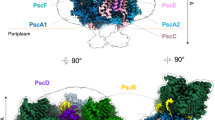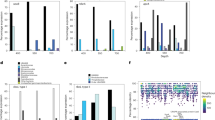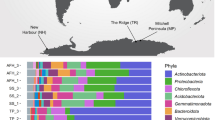Abstract
Green sulfur bacteria (GSB) (Chlorobiaceae) are primary producers that are important in global carbon and sulfur cycling in natural environments. An almost complete genome sequence for a single, dominant GSB species (‘C-Ace’) was assembled from shotgun sequence data of an environmental sample taken from the O2–H2S interface of the water column of Ace Lake, Antarctica. Approximately 34 Mb of DNA sequence data were assembled into nine scaffolds totaling 1.79 Mb, representing approximately 19-fold coverage for the C-Ace composite genome. A high level (∼31%) of metaproteomic coverage was achieved using matched biomass. The metaproteogenomic approach provided unique insight into the protein complement required for dominating the microbial community under cold, nutrient-limited, oxygen-limited and extremely varied annual light conditions. C-Ace shows physiological traits that promote its ability to compete very effectively with other GSB and gain dominance (for example, specific bacteriochlorophylls, mechanisms of cold adaptation) as well as a syntrophic relationship with sulfate-reducing bacteria that provides a mechanism for the exchange of sulfur compounds. As a result we are able to propose an explanation of the active biological processes promoted by cold-adapted GSB and the adaptive strategies they use to thrive under the severe physiochemical conditions prevailing in polar environments.
Similar content being viewed by others
Log in or create a free account to read this content
Gain free access to this article, as well as selected content from this journal and more on nature.com
or
References
Allen MA, Lauro FM, Wiliams TJ, Burg D, Siddiqui KS, De Francisci D et al. (2009). The genome sequence of the psychrophilic archaeon, Methanococcoides burtonii: the role of genome evolution in cold adaptation. ISME J 3: 1012–1035.
Beatty JT, Overmann J, Lince MT, Manske AK, Lang AS, Blankenship RE et al. (2005). An obligately photosynthetic bacterial anaerobe from a deep-sea hydrothermal vent. Proc Natl Acad Sci USA 102: 9306–9310.
Biebl H, Pfennig N . (1978). Growth yields of green sulfur bacteria in mixed cultures with sulfur and sulfate reducing bacteria. Arch Microbiol 117: 9–16.
Blankenship RE, Olson JM, Miller M . (1995). Antenna complexes from green sulfur bacteria. In Blankenship RE, Madigan MT, Bauer CE (eds). Anoxygenic Photosynthetic Bacteria. Kluwer: Dordrecht, The Netherlands, pp 399–435.
Blum H, Beier H, Gross HJ . (1987). Silver staining of proteins in polyacrylamide gels. Electrophoresis 8: 93–99.
Borrego CM, Garcia-Gil LJ . (1994). Rearrangement of light harvesting bacteriochlorophyll homologs as a response of green sulfur bacteria to low light intensities. Photosynth Res 45: 21–30.
Borrego CM, Gerola PD, Miller M, Cox RP . (1999). Light intensity effects on pigment composition and organisation in the green sulfur bacterium Chlorobium tepidum. Photosynth Res 59: 159–166.
Bryant DA, Frigaard NU . (2006). Prokaryotic photosynthesis and phototrophy illuminated. Trends Microbiol 14: 488–496.
Buchanan BB, Arnon DI . (1990). A reverse KREBS cycle in photosynthesis: consensus at last. Photosynth Res 24: 47–53.
Burch MD . (1988). Annual cycle of phytoplankton in Ace Lake, an ice covered, saline meromictic lake. Hydrobiologica 165: 59–75.
Burke CM, Burton HR . (1988a). The ecology of photosynthetic bacteria in Burton Lake, Vestfold Hills, Antarctica. Hydrobiologia 165: 1–11.
Burke CM, Burton HR . (1988b). Photosynthetic bacteria in meromictic lakes and stratified fjords of the Vestfold Hills, Antarctica. Hydrobiologia 165: 13–23.
Burton HR . (1980). Methane in a saline Antarctic lake. In: Trudinger PA, Walter MR, Ralph, BJ (eds). Biogeochemistry of Ancient and Modern Environments. Australian Academy of Science: Canberra, Australia, pp 243–251.
Cavicchioli R . (2006). Cold-adapted Archaea. Nat Rev Microbiol 5: 331–343.
Chung S, Shen G, Ormerod J, Bryant DA . (1998). Insertional inactivation studies of the csmA and csmC genes of the green sulfur bacterium Chlorobium vibrioforme 8327: the chlorosome protein CsmA is required for viability but CsmC is dispensable. FEMS Microbiol Lett 164: 353–361.
Commichau FM, Forchhammer K, Stülke J . (2006). Regulatory links between carbon and nitrogen metabolism. Curr Opin Microbiol 9: 167–172.
Coolen MJL, Muyzer G, Schouten S, Volkman JK, Sinninghe Damsté JS . (2006). Sulfur and methane cycling during the Holocene in Ace Lake (Antarctica) revealed by lipid and DNA stratigraphy. In: Neretin, LN (ed.). Past and Present Marine Water Column Anoxia (NATO Science Series: IV-Earth and Environmental Sciences). Springer: Dordrecht, The Netherlands, pp 41–65.
de Mendoza D, Garwin JL, Cronan Jr JE . (1992). Overproduction of cis-vaccenic acid and altered temperature control of fatty acid synthesis in mutant Escherichia coli. J Bacteriol 151: 1608–1611.
Delcher AL, Harmon D, Kasif S, White O, Salzberg SL . (1999). Improved microbial gene identification with GLIMMER. Nucleic Acid Res 27: 4636–4641.
Eisen JA, Nelson KE, Paulsen IT, Heidelberg JF, Wu M, Dodson RJ et al. (2002). The complete genome sequence of Chlorobium tepidum TLS, a photosynthetic, anaerobic, green-sulfur bacterium. Proc Natl Acad Sci USA 99: 9509–9514.
Farr SB, Kogoma T . (1991). Oxidative stress response in Escherichia coli and Salmonella typhimurium. Microbiol Rev 55: 561–585.
Franzmann PD, Roberts NJ, Mancuso CA, Burton HR, McMeekin TA . (1991b). Methane production in meromictic Ace Lake, Antarctica. Hydrobiologica 210: 191–201.
Franzmann PD, Skyring GW, Burton HR, Deprez PP . (1988). Sulfate reduction rates and some aspects of limnology of four lakes and a fjord in the Vestfold Hills, Antarctica. Hydrobiologia 165: 25–33.
Frigaard NU, Bryant DA . (2004). Seeing green bacteria in a new light: genomics-enabled studies of the photosynthetic apparatus in green sulfur bacteria and filamentous anoxygenic phototrophic bacteria. Arch Microbiol 182: 265–276.
Frigaard NU, Bryant DA . (2006). Chlorosomes: antenna organelles in photosynthetic green bacteria. In: Shively JM (ed). Complex Intracellular Structures in Prokaryotes. Springer: Berlin, Germany, pp 79–114.
Frigaard NU, Bryant DA . (2008). Genomic insights into the sulfur metabolism of phototrophic green sulfur bacteria. In: Hell R, Dahl C, Knaff D, Leustek T (eds). Sulfur Metabolism in Phototrophic Organisms. Springer: New York, USA, pp 60–76.
Frigaard NU, Maresca JA, Yunker CE, Jones AD, Bryant DA . (2004). Genetic manipulation of carotenoid biosynthesis in the green sulfur bacterium Chlorobium tepidum. J Bacteriol 186: 5210–5220.
Frigaard NU, Matsuura K, Hirota M, Miller M, Cox RP . (1998). Studies of the location and function of isoprenoid quinones in chlorosomes from green sulfur bacteria. Photosynth Res 58: 81–90.
Fujita Y, Bauer CE . (2000). Reconstitution of light-independent protochlorophyllide reductase from purified BChl and BChN-BChB subunits. In vitro confirmation of nitrogenase-like features of a bacteriochlorophyll biosynthesis enzyme. J Biol Chem 275: 23583–23588.
Gatlin CL, Kleemann GR, Hayes LG, Link AJ, Yates III JR . (1998). Protein identification at the low femtomole level from silver-stained gels using a new fritless electrospray interface for liquid chromatography-microspray and nanospray mass spectrometry. Anal Biochem 263: 93–101.
Giangrossi M, Giuliodori AM, Gualerzi CO, Pon CL . (2002). Selective expression of the β-subunit of nucleoid-associated protein HU during cold shock in Escherichia coli. Mol Microbiol 44: 205–216.
Gibson JAE . (1999). The meromictic lakes and stratified marine basins of the Vestfold Hills, East Antarctica. Antarct Sci 11: 175–192.
Gomez Maqueo Chew A, Frigaard NU, Bryant DA . (2007). Bacteriochlorophyllide c C-82 and C-121 methyltransferases are essential for adaptation to low light in Chlorobaculum tepidum. J Bacteriol 189: 6176–6184.
Grau R, Gardiol D, Glikin GC, de Mendoza D . (1994). DNA supercoiling and thermal regulation of unsaturated fatty acid synthesis in Bacillus subtilis. Mol Microbiol 11: 933–941.
Graumann PL, Marahiel MA . (1999). Cold shock response in Bacillus subtilis. J Mol Microbiol Biotechnol 2: 203–209.
Griesbeck C, Schütz M, Schödl T, Bathe S, Nausch L, Mederer N et al. (2002). Mechanism of sulfide–quinone reductase investigated using site-directed mutagenesis and sulfur analysis. Biochemistry 41: 11552–11565.
Hauska G, Schoedl T, Remigy H, Tsiotis G . (2001). The reaction centre of green sulfur bacteria. Biochim Biophys Acta 1507: 260–277.
Heath RJ, Rock CO . (2002). The Claisen condensation in biology. Nat Prod Rep 19: 581–596.
Hohmann-Marriott M, Blankenship RE . (2007). Variable fluorescence in green sulfur bacteria. Biochim Biophys Acta 1769: 106–113.
Hunter WN . (2007). The non-mevalonate pathway of isoprenoid precursor biosynthesis. J Biol Chem 282: 21573–21577.
Imhoff JF . (2003). Phylogenetic taxonomy of the family Chlorobiaceae on the basis of 16S rRNA and fmo (Fenna–Matthews–Olson protein) gene sequence. Int J Syst Evol Microbiol 53: 941–951.
Imlay JA . (2003). Pathways of oxidative damage. Annu Rev Microbiol 57: 395–418.
Kim H, Li H, Maresca JA, Bryant DA, Savikhin S . (2007). Triplet excitation formation as a novel photoprotection mechanism in chlorosomes in Chlorobium tepidum. Biophys J 93: 192–201.
Kurtz S, Phillippy A, Delcher AL, Smoot M, Shumway M, Antonescu C et al. (2004). Versatile and open software for comparing large genomes. Genome Biol 5: R12.
Lauro FM, McDougald D, Thomas T, Willams TJ, Egan S, Rice S et al. (2009). The genomic basis of trophic strategy in marine bacteria. Proc Natl Acad Sci 106: 15527–15533.
Labourn-Parry J, Perriss SJ . (1995). The role and distribution of the autotrophic ciliate Mesodinium rubrum (Myrionecta rubra) in three Antarctic saline lakes. J Plankton Res 17: 1835–1850.
Li H, Bryant DA . (2009). Envelope proteins of the CsmB/CsmF and CsmC/CsmD motif families inuence the size, shape, and composition of chlorosomes in Chlorobaculum tepidum. J Bacteriol 191: 7109–7120.
Li H, Jubelirer S, Costas AMG, Frigaard NU, Bryant DA . (2009). Multiple antioxidant proteins protect Chlorobaculum tepidum against oxygen and reactive oxygen species. Arch Microbiol 191: 853–867.
Lim J, Thomas T, Cavicchioli R . (2000). Low temperature regulated DEAD-box RNA helicase from Antarctic archaeon, Methanococcoides burtonii. J Mol Biol 297: 553–567.
Makihara F, Tsuzuki M, Sato K, Masuda S, Nagashima KV, Abo M et al. (2005). Role of trehalose synthesis pathways in salt tolerance mechanism of Rhodobacter sphaeroides f. sp. denitrificans IL106. Arch Microbiol 184: 56–65.
Mallorqui N, Arellano JB, Borrego CM, Garcia-Gil LJ . (2005). Signatures of green sulfur bacteria in lower Pleistocene deposits from the Banyoles lacustrine area (Spain). J Paleolimnol 34: 271–280.
Mansilla MC, Cybulski LE, Albanesi D, de Mendoza D . (2004). Control of membrane lipid fluidity by molecular thermosensors. J Bacteriol 186: 6681–6688.
Manske AK, Glaeser J, Kuypers MMM, Overmann J . (2005). Physiology and phylogeny of green sulfur bacteria forming a monospecific phototrophic assemblage at a depth of 100 meters in the Black Sea. Appl Environ Microbiol 71: 8049–8060.
Maresca JA, Bryant DA . (2006). Two genes encoding new carotenoid-modifying enzyme in the green sulfur bacterium Chlorobium tepidum. J Bacteriol 188: 6217–6223.
Maresca JA, Gomez Maqueo Chew A, Ponsatí MR, Frigaard NU, Ormerod JG, Bryant DA . (2004). The bchU gene of Chlorobium tepidum encodes the C-20 methyltransferase in bacteriochlorophyll c biosynthesis. J Bacteriol 186: 2558–2566.
Maresca JA, Romberger SP, Bryant DA . (2008). Isorenieratene biosynthesis in green sulfur bacteria requires the cooperative actions of two carotenoid cyclases. J Bacteriol 190: 6384–6391.
Martínez-Alonso M, van Bleijswijk J, Gaju N . (2005). Diversity of anoxygenic phototrophic sulfur bacteria in the microbial mats of the Ebro Delta: a combined morphological and molecular approach. FEMS Microbial Ecol 52: 339–350.
Mas J, Van Gemerden H . (1995). Storage products in purple and green sulfur bacteria. In: Blankenship RE, Madigan MT, Bauer CE (eds). Anoxygenic Photosynthetic Bacteria. Kluwer: Dordrecht, The Netherlands, pp 973–990.
Mizushima T, Kataoka K, Ogata Y, Inoue R, Sekimizu K . (1997). Increase in negative supercoiling of plasmid DNA in Escherichia coli exposed to cold shock. Mol Microbiol 23: 381–386.
Morgan-Kiss RM, Chan LK, Modla S, Weber TS, Warner M, Czymmek KJ et al. (2009). Chlorobaculum tepidum regulates chlorosome structure and function in response to temperature and electron donor availability. Photosynth Res 99: 11–21.
Musat N, Halm H, Winterholler B, Hoppe P, Peduzzi S, Hillion F et al. (2008). A single-cell view on the ecophysiology of anaerobic phototrophic bacteria. Proc Natl Acad Sci USA 105: 17861–17866.
Noguchi H, Park J, Takagi T . (2006). MetaGene: prokaryotic gene finding from environmental genome shotgun sequences. Nucleic Acids Res 34: 5623–5630.
Overmann J . (2006). The family Chlorobiaceae. In: Dworkin M, Falkow S, Rosenberg E, Schleifer KH, Stackebrandt E (eds). The Prokaryotes: A Handbook on the Biology of Bacteria. Springer: New York, USA, pp 359–378.
Overmann J, Garcia-Pichel F . (2006). The phototrophic way of life. In: Dworkin M, Falkow S (eds). The Prokaryotes: Ecophysiology and Biochemistry. Springer: New York, USA, pp 32–85.
Overmann J, Pfennig N . (1989). Pelodictyon phaeoclathratiforme sp. nov., a new brown-coloured member of the Chlorobiaceae forming net-like colonies. Arch Microbiol 152: 401–406.
Pfennig N . (1975). The phototrophic bacteria and their role in sulfur cycling. Plant Soil 43: 1–16.
Pfennig N . (1978). General physiology and ecology of phototrophic bacteria. In: Clayton RK, Sistrom WR (eds). The Photosynthetic Bacteria. Plenum Press: New York, USA, pp 3–18.
Phillips JD, Whitby FG, Kushner JP, Hill CP . (2003). Stuctural basis for tetrapyrrole coordination by uroporphyrinogen decarboxylase. EMBO J 22: 6225–6233.
Rankin LM, Gibson JAE, Franzmann PD, Burton HR . (1999). The chemical stratification and microbial communities of Ace Lake, Antarctica: a review of the characteristics of a marine-derived meromictic lake. Polarforschung 66: 35–52.
Rodrigues DF, Tiedji JM . (2008). Coping with our cold planet. Appl Environ Microbiol 74: 1677–1686.
Rodriguez-Brito B, Rohwer F, Edwards RA . (2006). An application of statistics to comparative metagenomics. BMC Bioinformatics 7: 162.
Rusch DB, Halpern AL, Sutton G, Heidelberg K, Williamson S, Yooseph S et al. (2007). The Sorcerer II Global Ocean Sampling Expedition: Northwest Atlantic through Eastern Tropical Pacific. PLoS Biol 5: e77.
Russell NJ . (2008). Membrane components and cold sensing. In: Margesin R, Schinner F, Marx JC, Gerday C (eds). Psychrophiles: From Biodiversity to Biotechnology. Springer: Berlin, Germany, pp 177–190.
Saunders NFW, Ng C, Raftery M, Guilhaus M, Goodchild A, Cavicchioli R . (2006). Proteomic and computational analysis of secreted proteins with type I signal peptides from the Antarctic archaeon. J Proteome Res 5: 2457–2464.
Sørensen PG, Cox RP, Miller M . (2007). Chlorosome lipids from Chlorobium tepidum: characterization and quantification of polar lipids and wax esters. Photosynth Res 95: 191–196.
Teeling H, Meyerdierks A, Bauer M, Amann R, Glöckner FO . (2004). Application of tetranucleotide frequencies for the assignment of genomic fragments. Environ Microbiol 6: 938–947.
Vila X, Guyoneaud R, Cristina XP, Figueras JB, Abella CA . (2002). Green sulfur bacteria from hypersaline Chiprana Lake (Monegros, Spain): habitat description and phylogenetic relationship of isolated strains. Photosynth Res 71: 165–172.
Volkman JK, Burton HR, Everitt DA, Allen DI . (1988). Pigment and lipid composition of algae and bacterial communities in Ace Lake, Vestfold Hills, Antarctica. Hydrobiologica 165: 41–57.
Wächtershäuser G . 1990. Evolution of the first metabolic cycles. Proc Natl Acad Sci USA 87: 200–204.
Wahlund TM, Woese CR, Castenholz RW, Madigan MT . (1991). A thermophilic green sulfur bacterium from New Zealand hot springs, Chlorobium tepidum sp. nov. Arch Microb 156: 81–90.
Ward DM, Ferris MJ, Nold SC, Bateson MM . (1998). A natural view of microbial diversity within hot spring cyanobacterial mat communities. Microbiol Mol Biol Rev 62: 1353–1370.
Willams T, Ertan H, Ting L, Cavicchioli R . (2009). Carbon and nitrogen substrate utilization in the marine bacterium Sphingopyxis alaskensis strain RB2256. ISME J 3: 1036–1052.
Yaronskaya E, Grimm B . (2006). The pathway from 5-aminolevulinic acid to protochlorophyllide and protoheme. In: Grimm B, Porra RJ, Rüdiger W, Scheer H (eds). Chlorophylls and Bacteriochlorophylls: Biochemistry, Biophysics, Functions and Applications. Springer: New York, USA, pp 173–188.
Acknowledgements
We thank John Bowman, Louise (Cromer) Newman, Anthony Hull, John Rich and Martin Riddle in providing helpful discussion and logistical support associated with the Antarctic expedition. Special thanks to Karla Heidelberg for genuine assistance in initiating genome sequencing and for assistance with sampling design, and Ken Nealson for critically reviewing the paper. We also thank the reviewers for very insightful comments. The work of the Australian contingent was supported by the Australian Research Council and the Australian Antarctic Division. Mass spectrometric results were obtained at the Bioanalytical Mass Spectrometry Facility within the Analytical Centre of the University of New South Wales. This work was undertaken using infrastructure provided by NSW Government co-investment in the National Collaborative Research Infrastructure Scheme. Subsidized access to this facility is gratefully acknowledged. The work of JCVI members was supported by funding provided from the Gordon and Betty Moore Foundation.
Author information
Authors and Affiliations
Corresponding author
Additional information
Supplementary Information accompanies the paper on The ISME Journal website
Supplementary information
Rights and permissions
About this article
Cite this article
Ng, C., DeMaere, M., Williams, T. et al. Metaproteogenomic analysis of a dominant green sulfur bacterium from Ace Lake, Antarctica. ISME J 4, 1002–1019 (2010). https://doi.org/10.1038/ismej.2010.28
Received:
Revised:
Accepted:
Published:
Issue date:
DOI: https://doi.org/10.1038/ismej.2010.28
Keywords
This article is cited by
-
Diverse transformations of sulfur in seabird-affected sediments revealed by microbial and stable isotope analyses
Journal of Oceanology and Limnology (2023)
-
Remarkably coherent population structure for a dominant Antarctic Chlorobium species
Microbiome (2021)
-
Genomic evidence for sulfur intermediates as new biogeochemical hubs in a model aquatic microbial ecosystem
Microbiome (2021)
-
Influence of the polar light cycle on seasonal dynamics of an Antarctic lake microbial community
Microbiome (2020)
-
Metaproteomics reveal that rapid perturbations in organic matter prioritize functional restructuring over taxonomy in western Arctic Ocean microbiomes
The ISME Journal (2020)



